Ombuds Annual Report: Creating our Office of the Auditor General of CanadaOAG Culture Together
September 2020 to August 2021
Message from the Ombuds—A Year in the Life of the OAG
As I sit down to write my second annual report, I love the challenge of looking for trends or insights that might help improve our well-being as an organization and as individuals. And what a year it has been. For most of us, these unusual times have brought unprecedented change to our personal and professional lives.
At the organizational level, our new Auditor General and Executive Committee have articulated an ambitious vision, mission, and strategic direction. An increase in base funding allowed the OAG to commit to modernizing and undertaking significant hiring. Auditing the government’s pandemic response created pressure to deliver timely findings. And all of this was done with the pandemic still ongoing.
At the same time, remote work forced each of us to rethink how we do our jobs. I heard from many of you about the collision of your work and home lives. (Please see the completely unscientific Remote Work: Roses and Thorns for a summary of what I heard on this topic.)
As a backdrop to all of this change has been an active conversation about our OAG culture. What is it? What do we want it to be? What’s holding us back? These conversations feel more relevant than ever as we imagine and design the OAG of the future. The conversation has been tense at times, as people express their different views and concerns.
I think of culture as a powerful invisible force that we shape together in our daily interactions and in how we show up as individuals. A healthy workplace culture is not something we can take for granted. As individuals we need to be mindful of how we treat one another, while decision makers should strive to integrate well-being considerations into all aspects of the work. Together, we create our culture.
It is my privilege to serve as the OAG Ombuds, listening to employees and managers as they confront difficult situations and providing information about available options for reaching a resolution. Thank you for your trust and your support.
Remote Work: Roses and Thorns
Top 10 roses
- Better work-life balance and flexibility
- No commute
- Location independence
- More level playing field for regional offices
- Some increases in productivity and performance
- Acceleration of technology rollout to enable remote work
- Some process efficiencies
- More creative ways to connect and recruit a more diverse workforce
- Greater acknowledgement of the importance of self-care and mental health
- Increased potential for a happier, healthier work life
Top 6 thorns
- Collision of personal and work lives
- Mental health impacts
- Workload and deadline management
- Effects of isolation, including some declines in productivity and efficiency
- Physical well-being, including meeting fatigue
- Inadequate home workspace
What I Heard This Year …
From September 2020 to August 2021, employees and managers discussed 94 different situations with me. Because the Ombuds service is informal and confidential, I do not maintain formal records, but I keep track of the topics raised by visitors so that I can share information about the kinds of issues that are affecting people in the workplace. I take note of 1 or 2 topics and outcomes, depending on the complexity of the case. The following are the top categories of topics raised this year and the percentage of cases in which each topic was raised.
Topics raised
 Wellness (raised in 48% of cases)
Wellness (raised in 48% of cases)
Wellness was the most common topic this year, with the following principal concerns in order of frequency:
- various mental health concerns, including
- high levels of work-related stress, including burnout
- significant stress related to personal circumstances
- worries related to COVID-19 and return to work (with some people eager to get back to the office and others reluctant to return)
- challenges with accommodation or returning to work after a prolonged absence
- difficult conversations related to diversity and inclusion
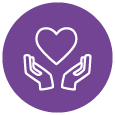 Organizational culture (raised in 28% of cases)
Organizational culture (raised in 28% of cases)
Culture was on people’s minds this year, as our new remote reality affected our relationship to our work. A few people spoke to me about what they appreciate in the OAG culture, in particular professionalism, friendly colleagues, and a shared commitment to the mission. Others raised concerns or perceptions of:
- a gap between what is described under the Care and Connect pillars of the strategic plan and the employee’s experience
- a lack of support, engagement, or collaboration
- unclear or unfair roles and responsibilities
- fear of reprisal for speaking up
 Communication challenges and conflict (raised in 27% of cases)
Communication challenges and conflict (raised in 27% of cases)
I see healthy conflict as a normal part of human relationships, and I believe we can all work to continuously improve our interpersonal skills, starting with our ability to listen. I am encouraged by the number of people who reached out to me for assistance in preparing for a difficult conversation or improving a challenging relationship. Of these situations,
- 15 were related to supervisor-employee dynamics
- 10 touched on relationships among colleagues
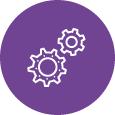 Concerns over process (raised in 17% of cases)
Concerns over process (raised in 17% of cases)
The majority of these situations involved people looking for additional information or for a neutral sounding board related to a staffing process or practice they considered unfair or unclear. I also heard from a smaller number of employees about other processes such as classification, promotion, and discipline.
 Leadership and management style (raised in 16% of cases)
Leadership and management style (raised in 16% of cases)
According to the National Standard of Canada for Psychological Health and Safety in the Workplace, effective leadership increases employee morale, resiliency, and trust and decreases employee frustration and conflict. Leaders who maintain their own physical and psychological health can also influence employees’ health. The main concerns I heard about this year include
- a lack of trust in the supervisor–employee relationship at various levels, with employees sometimes perceiving that the supervisor does not have the employee’s best interest at heart
- a lack of support
- abrasive interpersonal styles
A small number of people also raised issues of favouritism, lack of autonomy, and lack of recognition.
 Harassment and incivility (raised in 16% of cases)
Harassment and incivility (raised in 16% of cases)
It’s hard to overstate the importance of being respectful and considerate to the people we work with and the entities we serve. When a workplace lacks civility and respect, it can lead to emotional exhaustion, health problems, increased conflict, and job withdrawal. Understanding each other’s communication styles and preferences can help prevent misunderstandings and conflicts. Examples of issues raised include
- offensive remarks, including condescending or insulting comments
- abrupt or abrasive communication style, including in emails
In a small number of situations, people also shared allegations of perceived discrimination and harassment.
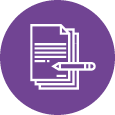 Workload management (raised in 13% of cases)
Workload management (raised in 13% of cases)
Most employees find that challenging work is fulfilling and rewarding. Intensive job demands, however, can result in physical, psychological, and emotional fatigue, particularly when they are accompanied by lack of control over the situation. Some OAG teams and employees found themselves under considerable stress this year trying to meet deadlines and expectations that they felt were outside of their control.
Often, even when there are high demands, if employees have high decision-making ability and open dialogue with their managers, they will be able to thrive. Regular communication about workload, including collaborative work planning and task prioritization, can help prevent workload stress and strain.
 Performance management (raised in 13% of cases)
Performance management (raised in 13% of cases)
Situations where an employee is not meeting their manager’s expectations can be very challenging for both parties. Many managers are good at analyzing situations, making quick decisions, and coming up with solutions. But these same skills can backfire when trying to support an employee who is struggling and who may not be able to express what they are experiencing and what they need.
Difficult performance discussions call for patience, trust, and listening from both parties. Both parties should also reach out promptly for tools, resources, and support to help them navigate a potentially stressful situation and to look after their own well-being. For Audit Services Group (ASG) employees, this includes the support that their union can provide.
Main topics by yearNote *
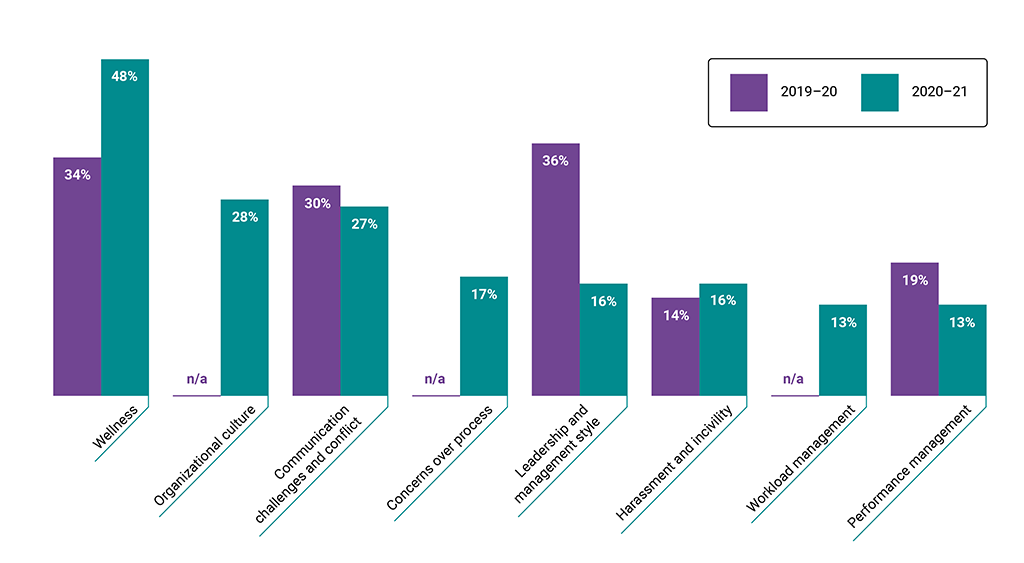
Text version
| 2019–20 | 2020–21 | |
|---|---|---|
| Wellness | 34% | 48% |
| Organizational culture | Not available | 28% |
| Communication challenges and conflict | 30% | 27% |
| Concerns over process | Not available | 17% |
| Leadership and management style | 36% | 16% |
| Harassment and incivility | 14% | 16% |
| Workload management | Not available | 13% |
| Performance management | 19% | 13% |
Number of cases in proportion to the number of OAG employees
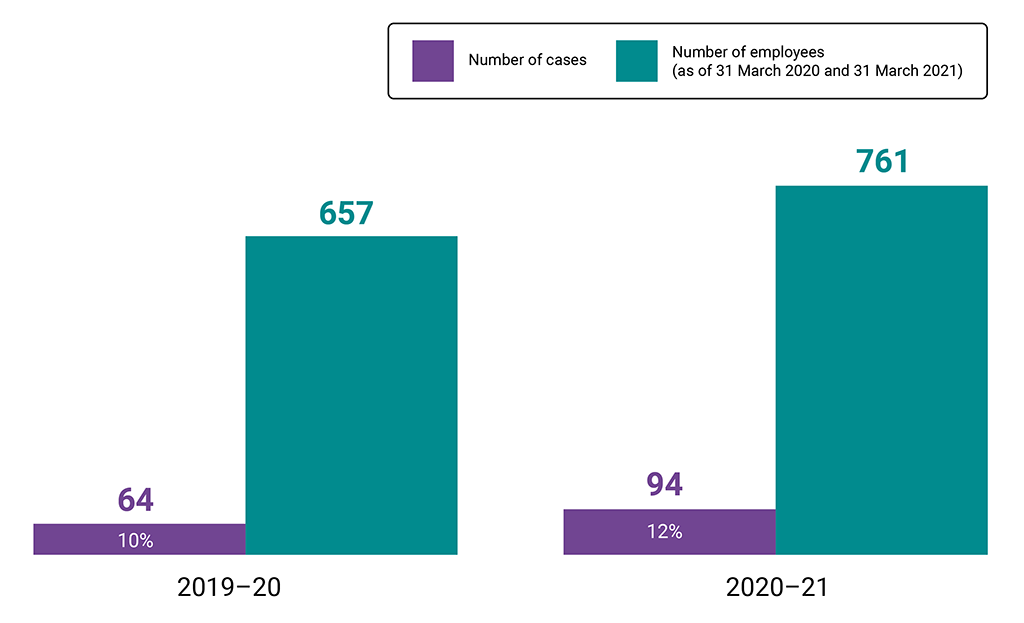
Text version
| 2019–20 | 2020–21 | |
|---|---|---|
| Number of cases | 64 | 94 |
| Number of employees (as of 31 March 2020 and 31 March 2021) | 657 | 761 |
| Percentage | 10% | 12% |
Other topics raised this year, in order of frequency
- Growth and development
- Official languages
- Values and ethics
- Privacy
- Pay and benefits
Ombuds’ role at the OAG
- Provide a safe environment where employees can discuss and resolve work-related issues in confidence.
- Monitor the pulse of the organization, share information, and provide upward feedback to encourage a healthy environment.
Outcomes
People contact the Ombuds for various reasons—very often it’s the opportunity to be heard by a neutral party. In other situations, people are looking for help about what resources or options may be available to them, or they may request that their issue be flagged confidentially to other parties in the hopes of resolving a systemic irritant. Following are the top outcomes from this year’s cases, and the percentage of situations in which they occurred.
- I provided visitors with a sounding board and an opportunity to be heard in 52% of situations.
- I helped identify options for resolution in 39% of situations.
- I shared feedback with management or other stakeholders while protecting the visitor’s identity in 17% of situations.
- I provided resources or tools in 13% of situations.
- I obtained information from other sources on the visitor’s behalf in 11% of situations.
- I referred a visitor to another resource, internal or external, in 7% of situations.
- I helped a visitor to use a direct approach such as coaching, role-playing, scripting in 6% of situations.
Other outcomes, in order of frequency
- I raised a specific case with management or stakeholders with the visitor’s permission.
- I conducted an exit interview and shared results with Human Resources with the visitor’s permission.
- I provided informal shuttle diplomacy, which means facilitating communication without bringing parties together.
- I obtained another party’s perspective on the visitor’s behalf.
- I facilitated a discussion between parties.
Outreach and engagement
In addition to meeting with employees and managers to discuss their situations, I get involved in a range of initiatives to listen, learn, and contribute my perspective. These include the Interdepartmental Committee of Organizational Ombuds and the Clerk’s Contact Group on Mental Health. I also hold observer status on various committees and provide input to projects, such as diversity and inclusion, the Culture Initiative, the mental health strategy, and the talent management strategy. I regularly engage with members of the OAG management team, the Audit Committee, employee groups, and various stakeholders. And I meet with teams on request to discuss issues related to organizational well-being.
Bottom line: Please reach out to me if there is a conversation or initiative you would like me to be involved in.
Contacting the Ombuds is easy
- Reach out to me by Microsoft Teams, email, or phone.
In Closing …
I was happy last year when my first annual report led to good conversations about workplace well-being. Here are a few important questions that came up that I find relevant again this year.
1. Why don’t you formulate recommendations in your report? How do you know that management will be accountable for addressing the issues you are raising?
When I consider the number of initiatives that relate directly or indirectly to the topics raised in my report, the list is long. There’s the strategic plan, the mental health strategy, Not Myself Today, the professional development curriculum and leadership development program, the reverse mentors, OAG Flex, the resourcing plan, new efforts at formal upward feedback, new internal communications channels, and the initiatives related to culture (including the change agents), talent management, and diversity and inclusion.
I’m sure this list is incomplete. For a relatively small organization, I find this to be a lot, so I am reluctant to suggest additional enterprise-wide solutions. Rather, I encourage management and employees to invest and engage in the current initiatives to maximize the benefit for the whole organization. I hope that the people who read this report will reflect on their own experience and look for ways to contribute to a healthy respectful work environment and create our culture together.
2. What is your advice to managers who are struggling to balance their teams’ mental health with a very demanding workload?
Many managers have felt the strain of looking after their teams while their own reserves are being exhausted. It is not easy, but managers need to lead by example by looking after themselves, setting boundaries, and finding ways to replenish their own reserves on a daily basis. Please don’t wait until you feel sick or overwhelmed to start taking care of yourself.
Actively involve team members in developing strategies to manage workload, such as setting priorities, reducing redundant or unnecessary tasks, and managing deadlines. Encourage genuine connections in your team, fostering collaboration and openness. Take the pulse regularly with your employees to check how they are doing and remind them of all the resources available to them. Finally, make sure that your own manager is aware of the challenges that you and your team are facing—they may be able to help you find solutions.
3. What can you share about how the diversity and inclusion priority relates to the issues you are observing in the workplace?
The OAG has reiterated its commitment to a diverse, inclusive, and equitable workplace where everyone feels a sense of belonging and can achieve their potential. This sounds like something we can all get behind, so why is it hard work?
Making space for difference can be challenging. Integrating diverse viewpoints takes time and challenges our thinking, our listening and communication skills, and our conflict competence. It is inherently difficult to admit we have biases, to critically assess our unconscious beliefs, and to acknowledge the invisible barriers that can lead to inequities in our workplace.
As Ombuds, acknowledging the privilege of my position and my personal background, I am committed to listening and learning from all the parties along this journey and to doing my part to foster a workplace where we all feel we belong.
Janet Campbell, Ombuds